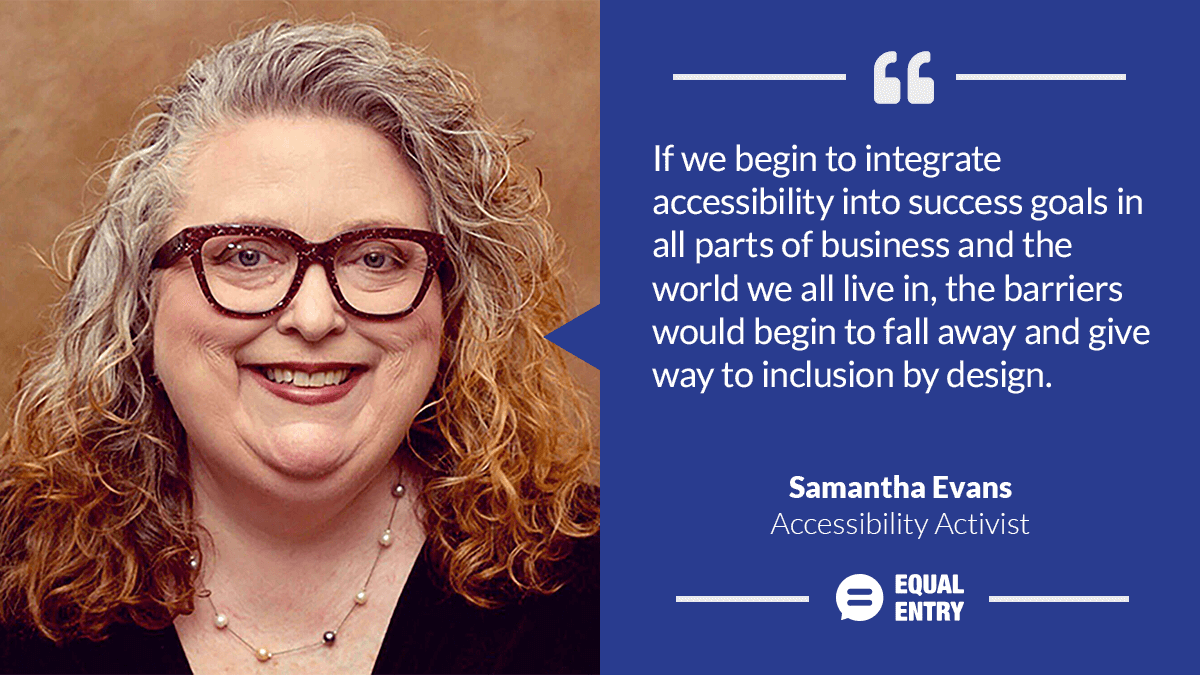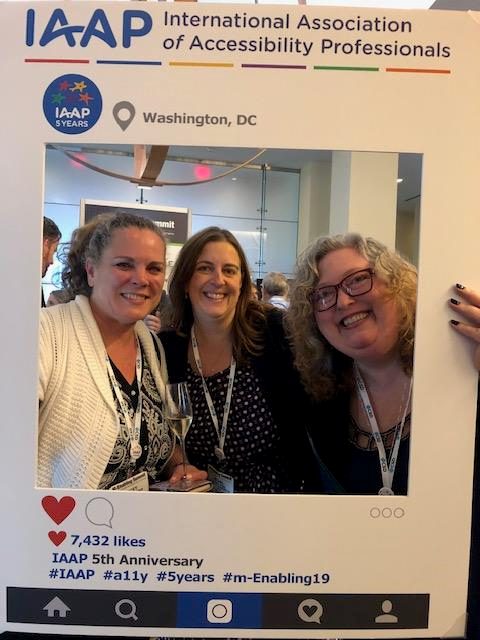
Samantha Evans is the Certification Manager at the International Association of Accessibility Professionals (IAAP). Her role focuses on promoting, guiding, and developing a series of professional and technical certification programs to establish benchmarks of accessibility skills and knowledge.
How did you get your start in accessibility?
Like most people in the accessibility community, I came to learn about accessibility from a personal experience. My roommate of 20 years lost her vision to a rare retina disorder. Along the way, pre-internet, finding resources for low-vision living was scarce. So we improvised a lot. And I learned about so many challenges she was faced with and how many barriers the world presented. Adaptive strategies were the name of the game.
My first job out of grad school was managing an association. My meeting planner required that we consider built-environment accessibility and wayfinding in all of our site visits. Little did I know she was way ahead of the curve. That was 2001. So my event planning and meeting planning have always included access for mobility and what was reasonable for actual usability.
Fast forward to work in a boutique branding and strategy agency. I’m giving a creative concepts presentation and ready to launch into implementation. The communications manager sat across from me and asked if our wire-frames were accessible. I had no idea what that meant, but I knew it was important. They told us if they weren’t they couldn’t work with them.
I learned they came from an advocacy organization for disabled children. And then I spent the better part of that evening on the phone with some very kind accessibility experts that explained what accessible wireframes meant, and how we could improve them for a start. They also taught me to say “way-kag: for WCAG.
Five years ago, I interviewed for an account manager position at an alternative media and accessible solutions direct services agency. When I explained that I understood what WCAG and digital accessibility meant, they were thrilled. I then learned alongside top-notch e-text, braille, captioning, and website auditing teams. That was just after the start of IAAP’s certification initiatives.
As the Certification Manager for the International Association of Accessibility Professionals, you are responsible for promoting the value of the various professional and technical certification programs across the industry and beyond. How would you describe the return on investment for these programs to the uninitiated?
In any profession where people share common goals, best practices, and knowledge, certification programs offer a way to establish expectations and benchmarks for said profession. You may ask yourself, “What’s in it for me?” The most common feedback from those who have earned our certifications is that the process of preparing for their exam expanded their knowledge and understanding of disability, accessibility, and the work we do to remove barriers everyday.
Even members of the community who many consider mentors and senior contributors to our profession have reinforced this core concept. While certifications utilize an exam as an assessment, the process of preparation, research, and studying enhances our collective strength and knowledge. This is the true gift of any professional certification, beyond the credential itself.

People who have earned certifications can provide proof of knowledge and capacity to convert concepts into actionable outcomes. Completion and maintenance of professional certifications are a commitment to your profession. Each certification in addition to a person’s own professional history will help them differentiate themselves and stand out from the competition.
The requirement for ongoing Continuing Accessibility Education Credits (CAECs pronounced like “cakes”) and participation in the world of other certification holders provides educational opportunities to keep up with the fast-paced and often rapidly changing profession and the industries we serve. The relationships built within the IAAP Certification community provides a network of colleagues that can become resources, advisors, collaborators, and possible future opportunities for career advancement.
People who hold our certifications have the capacity to be thoughtful, contribute to inclusive design at concepts, adapt strategies during processes, and help all teams achieve better results. Accessibility professionals incorporate accessibility knowledge, helping organizations recognize optimized outcomes with fewer resources.
This makes the accessibility professional a valuable asset internally and to the audiences each organization serves. Our certifications are signals that removing barriers and building inclusive futures is what we do. That’s a pretty amazing ethos for any profession.
What is an accessibility barrier you would like to see solved?
Let’s do away with the concept that accessibility belongs to only a few people in a few roles.
I would like to see accessibility and inclusion taught across disciplines in higher education, in communications, marketing, advertising, research, business operations, writing, health/medicine, nursing, psychology, technology, design, engineering, and computer sciences. If we can integrate inclusion, real inclusion as part of how we educate young people about the world, it is possible to position generations of future leaders to be inclusive by design.

In the workforce, I would like to see accessibility become a standard part of job descriptions and responsibilities from finance and procurement, to marketing/communications, to management and HR, to IT, to customer success, and in direct service delivery. If we begin to upskill and integrate accessibility into success goals in all parts of business and the world we all live in, the barriers would begin to fall away and give way to inclusion by design.